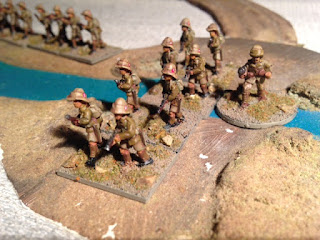In 1914 each infantry Division included a Signals Company with a total strength of 162 men. It was organised into a Company HQ and 4 Sections, of which No 1 Section was responsible for communications with Divisional HQ and Nos 2-4 with the Brigades of the Division.
Source: http://www.1914-1918.net/whatfieldcoy.htm
Among the equipment available to the signallers, was the heliograph which employed a mirror (often mounted on a tripod) that was used to 'flash' Morse Code.
You can see some original footage of a heliograph in action here:
The heliograph was valued for its mobility, being quick to set up. It was a cheap signalling system with an impressive communication range in the right terrain. A 5 inch reflector had a signalling distance of some 50 miles (80 km), whilst the 9 or 12 inch models had a range of up to 80 miles (130 km). Best of all, in the Middle East theatre, there was plenty of sun!
Signals posts play an important role in the command system of If the Lord Spares us (ITLSU) rules by increasing the distance over which Battalion COs can operate effectively from the Brigade Commander-in-Chief.
There are no signals figures among the Eureka 15mm range so some conversion was necessary to obtain some signal posts. I have always liked the iconic images of heliograph teams operating in Egypt and Palestine, so wanted to put together some for my British.
The figures that provided the best conversion opportunity were the British in Sinai Artillery Crew (300HBC84). Here's a few pictures of how I approached the conversion.
 |
| I made some holes for the tripod using a heated nail. This is a 30mm base (~ 1 1/4 ") and the holes are 6mm (1/4") apart. |
 |
| The tripod legs are glued in place. |
 |
| The standing signaller has his base trimmed so the front foot will fit between the tripod legs. Then, the signallers are ready to go! |
 |
| The mirror 'frame' is then glued in place. |
 |
| The crew are mounted in place. |
As these teams will be supporting units of the 42nd Division (East Lancashire), I'm designating these as signallers from the 427th Field Company - identified thanks to the excellent resource on the Field Companies of the Royal Engineers on The Long, Long Trail.
 |
| A group of men of 527 (2nd Durham) Field Company, a Territorial unit that served under command of 5th Division. |












